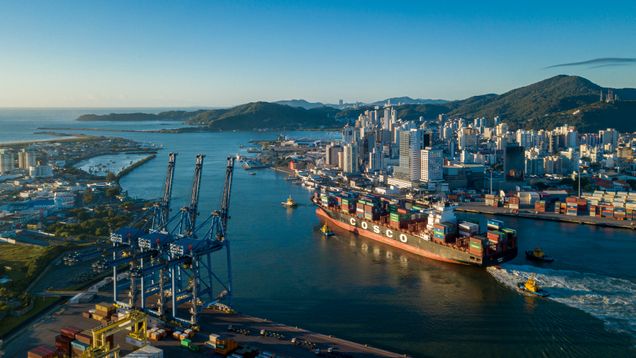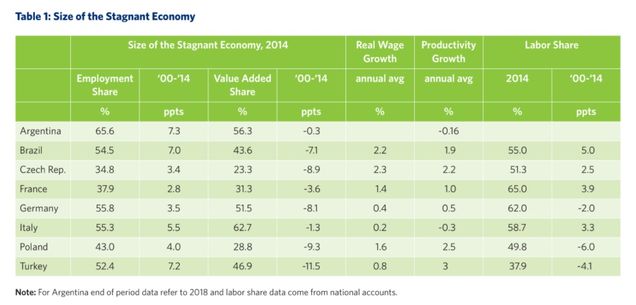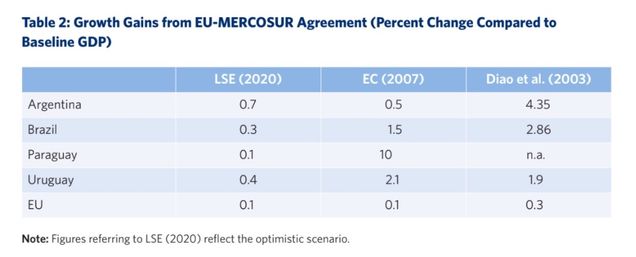

By Özlem Ömer and Jeronim Capaldo
The proposed trade agreement between the European Union and the South American trade bloc MERCOSUR poses serious risks to economic development. But one wouldn’t know that from economic projections and most existing studies of the subject. As is traditional in trade policy rhetoric, projections of the EU-MERCOSUR agreement rule out the possibility of unemployment, growing inequality and other problems by discarding critical information on economic transformations at play. When the latter are seriously considered, more trade liberalization is revealed as a step in the wrong direction without complementary policies that directly tackle the need to expand sectors where employment is highly productive and better paid.
The starting point for a sensible analysis of the agreement (indeed, any trade agreement), is to consider the structural features of the economies involved. Publicly available data go a long way in this direction and basic algebra helps understand the role played by each sector of the economy. Focusing on Argentina, Brazil, Czech Republic, France, Italy, Germany, Poland and Turkey, and distinguishing between “dynamic” and “stagnant” sectors of the economy (i.e., sectors where productivity and wages grow fast, as opposed to sectors where they stagnate), our new working paper shows three main results:
Three groups of countries emerge from the data: economies that were recently industrializing (Czech Republic and Poland), advanced economies that were recently de-industrializing (including Germany, France and Italy) and developing economies that were recently de-industrializing (Argentina, Brazil and Turkey). Results show that employment has been created mostly in stagnant sectors, as shown in Table 1:

After 2000, 3-7 percent of jobs shifted from dynamic to stagnant sectors, while up to 9 percent of value added shifted away from these sectors, threatening domestic demand growth and income distribution.
This remarkable shift, has occurred in each country studied and has been the main cause of the downward trend of productivity growth, also observed in all countries, and of the widespread increase in inequality. The EU-MERCOSUR agreement can make these trends worse, as it does not provide the policy tools to support the necessary economic transformation—especially in MERCOSUR.
Existing projections of the agreement’s effects, based on model simulations, point to small or negligible gains in terms of GDP for the countries surveyed, as shown in Table 2:

These gains are a short-lived occurrence, rather than the start of a period of faster growth, which in any case must be understood as the most optimistic outlook, considering these studies assume away any adverse effects on employment, inequality, industrialization, development and more. Furthermore, policymakers should be cautious about using existing model projections when assessing the impacts of the agreement, as the results of the simulations are driven by three unrealistic assumptions: full employment, constant income inequality and fixed productivity growth.
For a country’s growth to be economically “sustainable,” productivity must increase, and inequalities must decrease. In all countries, this means expanding the “dynamic” sectors that offer higher paying jobs. In developing countries, it also means continuing to industrialize (increasing manufacturing’s shares in both value-added and employment) until they can compete in higher value-added market segments. This requires active industrial policy and coordinated policies in many areas, including credit, investment and income policies. It also requires multilateral institutions to support the necessary national policies and provide external support, especially technology transfer. In this context, the trade regime plays a critical role, because it can help or impede the technological and structural transformations that determine who wins and who loses in the long term. In practice, free trade agreements have promoted specialization rather than diversification, based on countries’ existing productive structures. Countries that have not advanced in high-productivity manufacturing and related sectors tend to lose out. Technologically advanced (developed) countries tend to win and consolidate their technological advantage.
Representing another wave of trade liberalization, the EU-MERCOSUR agreement will likely accelerate the expansion of stagnant sectors in Argentina and Brazil, such as agri-food and mining (also the sectors with some of the heaviest climate and environmental impacts), while leading to the relative contraction of the most dynamic sectors, including vehicle, transport machinery and electronic equipment.
High-productivity sectors in some EU countries may benefit in principle from access to MERCOSUR markets. But the adverse structural transformation that the agreement is likely to accelerate in these countries will undermine the growth of their domestic demand, including the part that is directed to imports. While the export boost is projected to be marginal and short-lived, high-end economic output in the EU is unlikely to expand substantially and stronger cost competition in more stagnant sectors is likely to undermine their wage and productivity growth, ultimately compromising economy-wide demand expansion and leading to a deterioration of income distribution.
Countries in the EU that are still industrializing – such as Poland and Czech Republic – may have a better chance at benefitting from the agreement, provided that they can keep up their growth and productivity performances and reduce inequality. If this happens, competitiveness gains and expansion of dynamic sectors (such as vehicle, transport machinery and electronic equipment) may help reduce the imbalance between dynamic and stagnant sectors. It is, however, a risky path and one already challenged by the economic pressures of the COVID-19 pandemic. In any case, it would be a minor win among a broader set of negative trends accelerated by the agreement.
The EU-MERCOSUR agreement may well be a step toward less productive, more unequal and more vulnerable economies in both regions. These risks may or may not materialize, but they are assumed away in existing assessments of the agreement, which are not, therefore, an informative basis for policy choices.
Posted 3 years ago on Monday, June 7th, 2021